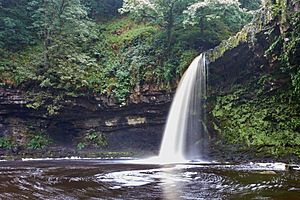Afon Pyrddin facts for kids
The Afon Pyrddin is a cool river in Wales, Great Britain. It helps mark the border between two areas called Brecknockshire and Glamorgan. It also forms part of the edge of the amazing Brecon Beacons National Park. This river and its beautiful waterfalls are a big reason why the Fforest Fawr Geopark was created in 2005.
The name 'Pyrddin' might mean 'river by the strong fort' or 'sweet-flowing river'. Both sound pretty cool, right?
Three smaller streams, Nant y Bryn, Nant y Fedwen, and Nant Hir, join together to form the Pyrddin. The river then flows towards the south-east for about 3 miles (5 kilometers). It eventually meets another river called the Nedd Fechan.
Amazing Waterfalls
The Afon Pyrddin is most famous for its two incredible waterfalls. They are called Sgwd Gwladus and Sgwd Einion Gam. These names mean 'the fall of Gwladus' and 'the fall of crooked Einion'. Gwladus and Einion are old Welsh names.
Sgwd Gwladus is formed where the river flows over a very strong type of rock. This rock is called 'Twelve Foot Sandstone'. It's like a hard lip that the water plunges over. You can easily reach this waterfall by following a path from Pontneddfechan.
Above Sgwd Gwladus, there used to be a large, balanced rock that could actually rock back and forth! People say it was moved sometime in the 1800s. Near the falls, you can also see the old ruins of a small building. People think it might have been a mill for grinding corn.
Sgwd Einion Gam is about half a mile further upstream. To get to this waterfall, you need to cross the river a few times. This fall is created because of a natural break in the rocks, called a fault. This fault brings a very hard rock, known as 'Farewell Rock', right next to softer, muddy rocks. This difference in rock hardness makes the water plunge down.
Nature's Home: Special Protection
The steep, wooded valley of the Pyrddin is a special place for nature. Just like its nearby rivers, the Nedd Fechan, Afon Mellte, and Afon Hepste, it's home to many rare and tiny plants. These plants, called bryophytes, love the cool, damp conditions found here.
Because of these special plants, the area has been given important protection. It's known as a Site of Special Scientific Interest and a special area of conservation. This means the area is protected to keep its unique natural environment safe for everyone to enjoy.


